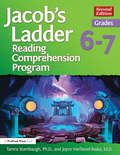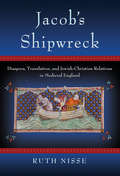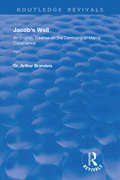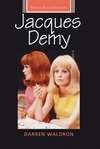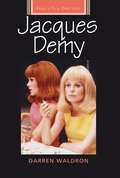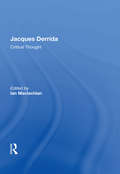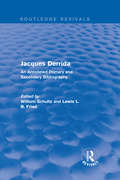- Table View
- List View
Jacob's Ladder Reading Comprehension Program: Grades 6-7
by Tamra Stambaugh Joyce VanTassel-BaskaThe Jacob's Ladder Reading Comprehension Program targets reading comprehension skills in high-ability learners by moving students through an inquiry process from basic understanding to critical analyses of texts, using a field-tested method developed by the Center for Gifted Education at William & Mary. Students in grades 6-7 will learn to comprehend and analyze any reading passage after completing the activities in Jacob's Ladder, Grades 6-7 (2nd ed., previously published as Level 4).Using skill ladders connected to short stories, poetry, essays, and nonfiction, students move from lower order, concrete thinking skills to higher order, critical thinking skills. The ladders include multiple skills necessary for academic success, covering language arts standards such as sequencing, determining cause and effect, classifying, making inferences, and recognizing main ideas, themes, and concepts. The second edition of the book builds off the previous Level 4 edition, including new readings and ladders for student use.This book provides teachers with an explanation of the nature of supplementary tasks that scaffold reading comprehension. Also included is an overview of the goals and objectives of the Jacob's Ladder tasks and suggestions for implementation, giving every teacher the tools needed to promote successful reading comprehension.Optional Student Workbook PacksIn addition to this teacher's guide, companion student workbooks are available for Poetry, Short Stories, and Biographies. The student workbooks feature ample room for student responses and notes, make reviewing and providing feedback on student work easier than ever, provide students with an easy-to-use reference to use during discussions, and save time, as there is no need to reproduce student handouts.Grades 6-7
Jacob's Ladder Reading Comprehension Program: Grades 7-8
by Joyce VanTassel-Baska Tamra StambaughThe Jacob's Ladder Reading Comprehension Program targets reading comprehension skills in high-ability learners by moving students through an inquiry process from basic understanding to critical analyses of texts, using a field-tested method developed by the Center for Gifted Education at William & Mary. Students in grades 7-8 will learn to comprehend and analyze any reading passage after completing the activities in Jacob's Ladder, Grades 7-8 (2nd ed., previously published as Level 5).Using skill ladders connected to short stories, poetry, essays, and nonfiction, students move from lower order, concrete thinking skills to higher order, critical thinking skills. The ladders include multiple skills necessary for academic success, covering language arts standards such as sequencing, determining cause and effect, classifying, making inferences, and recognizing main ideas, themes, and concepts. The second edition of the book builds off the previous Level 5 edition, including new readings and ladders for student use.This book provides teachers with an explanation of the nature of supplementary tasks that scaffold reading comprehension. Also included is an overview of the goals and objectives of the Jacob's Ladder tasks and suggestions for implementation, giving every teacher the tools needed to promote successful reading comprehension.Optional Student Workbook PacksIn addition to this teacher's guide, companion student workbooks are available for Poetry, Short Stories, and Biographies. The student workbooks feature ample room for student responses and notes, make reviewing and providing feedback on student work easier than ever, provide students with an easy-to-use reference to use during discussions, and save time, as there is no need to reproduce student handouts.Grades 7-8
Jacob's Ladder Reading Comprehension Program: Nonfiction Grade 3
by Joyce VanTassel-Baska Tamra StambaughThe Jacob's Ladder Reading Comprehension Program: Nonfiction targets reading comprehension skills in high-ability learners by moving students through an inquiry process from basic understanding to critical analyses of texts using a field-tested method developed by the Center for Gifted Education at William & Mary. Students in grade 3 will be able to comprehend and analyze any nonfiction reading passage after completing the activities in this book. Using skill ladders connected to individual readings related to essays, articles, comparison documents, infographics, and other nonfiction texts, students move from lower order, concrete thinking skills to higher order, critical thinking skills. All of the books, geared to increasing grade levels, include high-interest readings, ladders to increase reading skill development, and easy-to-implement instructions. The ladders include multiple skills necessary for academic success, covering language arts standards such as sequencing, cause and effect, classification, making generalizations, inference, understanding emotion, using and thinking about words, and recognizing themes and concepts.Optional Student Workbook PacksIn addition to this teacher's guide, companion student workbooks are available for Grade 3
Jacob's Ladder Reading Comprehension Program: Nonfiction Grade 4
by Joyce VanTassel-Baska Tamra StambaughThe Jacob's Ladder Reading Comprehension Program: Nonfiction targets reading comprehension skills in high-ability learners by moving students through an inquiry process from basic understanding to critical analyses of texts using a field-tested method developed by the Center for Gifted Education at William & Mary. Students in grade 4 will be able to comprehend and analyze any nonfiction reading passage after completing the activities in this book. Using skill ladders connected to individual readings related to essays, articles, comparison documents, infographics, and other nonfiction texts, students move from lower order, concrete thinking skills to higher order, critical thinking skills. All of the books, geared to increasing grade levels, include high-interest readings, ladders to increase reading skill development, and easy-to-implement instructions. The ladders include multiple skills necessary for academic success, covering language arts standards such as sequencing, cause and effect, classification, making generalizations, inference, understanding emotion, using and thinking about words, and recognizing themes and concepts.Optional Student Workbook PacksIn addition to this teacher's guide, companion student workbooks are available for Grade 4
Jacob's Ladder Reading Comprehension Program: Nonfiction Grade 5
by Joyce VanTassel-Baska Tamra StambaughThe Jacob's Ladder Reading Comprehension Program: Nonfiction targets reading comprehension skills in high-ability learners by moving students through an inquiry process from basic understanding to critical analyses of texts using a field-tested method developed by the Center for Gifted Education at William & Mary. Students in grade 5 will be able to comprehend and analyze any nonfiction reading passage after completing the activities in this book. Using skill ladders connected to individual readings related to essays, articles, comparison documents, infographics, and other nonfiction texts, students move from lower order, concrete thinking skills to higher order, critical thinking skills. All of the books, geared to increasing grade levels, include high-interest readings, ladders to increase reading skill development, and easy-to-implement instructions. The ladders include multiple skills necessary for academic success, covering language arts standards such as sequencing, cause and effect, classification, making generalizations, inference, understanding emotion, using and thinking about words, and recognizing themes and concepts.Optional Student Workbook PacksIn addition to this teacher's guide, companion student workbooks are available for Grade 5
Jacob's Ladder Reading Comprehension Program: Nonfiction Grade 5
by Joyce VanTassel-Baska Tamra StambaughThe Jacob's Ladder Reading Comprehension Program: Nonfiction targets reading comprehension skills in high-ability learners by moving students through an inquiry process from basic understanding to critical analyses of texts using a field-tested method developed by the Center for Gifted Education at William & Mary. Students in grade 5 will be able to comprehend and analyze any nonfiction reading passage after completing the activities in this book. Using skill ladders connected to individual readings related to essays, articles, comparison documents, infographics, and other nonfiction texts, students move from lower order, concrete thinking skills to higher order, critical thinking skills. All of the books, geared to increasing grade levels, include high-interest readings, ladders to increase reading skill development, and easy-to-implement instructions. The ladders include multiple skills necessary for academic success, covering language arts standards such as sequencing, cause and effect, classification, making generalizations, inference, understanding emotion, using and thinking about words, and recognizing themes and concepts.Optional Student Workbook PacksIn addition to this teacher's guide, companion student workbooks are available for Grade 5
Jacob's Ladder Reading Comprehension Program: Nonfiction Grade 4
by Joyce VanTassel-Baska Tamra StambaughThe Jacob's Ladder Reading Comprehension Program: Nonfiction targets reading comprehension skills in high-ability learners by moving students through an inquiry process from basic understanding to critical analyses of texts using a field-tested method developed by the Center for Gifted Education at William & Mary. Students in grade 4 will be able to comprehend and analyze any nonfiction reading passage after completing the activities in this book. Using skill ladders connected to individual readings related to essays, articles, comparison documents, infographics, and other nonfiction texts, students move from lower order, concrete thinking skills to higher order, critical thinking skills. All of the books, geared to increasing grade levels, include high-interest readings, ladders to increase reading skill development, and easy-to-implement instructions. The ladders include multiple skills necessary for academic success, covering language arts standards such as sequencing, cause and effect, classification, making generalizations, inference, understanding emotion, using and thinking about words, and recognizing themes and concepts.Optional Student Workbook PacksIn addition to this teacher's guide, companion student workbooks are available for Grade 4
Jacob's Ladder Reading Comprehension Program: Grades K-1
by Joyce VanTassel-Baska Tamra StambaughThe Jacob's Ladder Reading Comprehension Program targets reading comprehension skills in high-ability learners by moving students through an inquiry process from basic understanding to critical analyses of texts, using a field-tested method developed by the Center for Gifted Education at William & Mary. Students in grades K-1 will learn to comprehend and analyze any reading passage after completing the activities in Jacob's Ladder, Grades K-1 (2nd ed.).Geared for students in grades K-1, this book, a revision of the Primary Level 1 book, includes stories and ladder tasks carefully selected for young children to develop oral communication and listening skills in addition to the other ladder goals. This book provides stories focused on picture analysis, read alouds, classics, and original works.Optional Student Workbook PacksIn addition to this teacher's guide, companion student workbooks are available for Grades K-1
Jacob's Ladder Reading Comprehension Program: Nonfiction Grade 3
by Joyce VanTassel-Baska Tamra StambaughThe Jacob's Ladder Reading Comprehension Program: Nonfiction targets reading comprehension skills in high-ability learners by moving students through an inquiry process from basic understanding to critical analyses of texts using a field-tested method developed by the Center for Gifted Education at William & Mary. Students in grade 3 will be able to comprehend and analyze any nonfiction reading passage after completing the activities in this book. Using skill ladders connected to individual readings related to essays, articles, comparison documents, infographics, and other nonfiction texts, students move from lower order, concrete thinking skills to higher order, critical thinking skills. All of the books, geared to increasing grade levels, include high-interest readings, ladders to increase reading skill development, and easy-to-implement instructions. The ladders include multiple skills necessary for academic success, covering language arts standards such as sequencing, cause and effect, classification, making generalizations, inference, understanding emotion, using and thinking about words, and recognizing themes and concepts.Optional Student Workbook PacksIn addition to this teacher's guide, companion student workbooks are available for Grade 3
Jacob's Ladder Reading Comprehension Program: Grades K-1
by Joyce VanTassel-Baska Tamra StambaughThe Jacob's Ladder Reading Comprehension Program targets reading comprehension skills in high-ability learners by moving students through an inquiry process from basic understanding to critical analyses of texts, using a field-tested method developed by the Center for Gifted Education at William & Mary. Students in grades K-1 will learn to comprehend and analyze any reading passage after completing the activities in Jacob's Ladder, Grades K-1 (2nd ed.).Geared for students in grades K-1, this book, a revision of the Primary Level 1 book, includes stories and ladder tasks carefully selected for young children to develop oral communication and listening skills in addition to the other ladder goals. This book provides stories focused on picture analysis, read alouds, classics, and original works.Optional Student Workbook PacksIn addition to this teacher's guide, companion student workbooks are available for Grades K-1
Jacob's Ladder Reading Comprehension Program: Grades 7-8
by Joyce VanTassel-Baska Tamra StambaughThe Jacob's Ladder Reading Comprehension Program targets reading comprehension skills in high-ability learners by moving students through an inquiry process from basic understanding to critical analyses of texts, using a field-tested method developed by the Center for Gifted Education at William & Mary. Students in grades 7-8 will learn to comprehend and analyze any reading passage after completing the activities in Jacob's Ladder, Grades 7-8 (2nd ed., previously published as Level 5).Using skill ladders connected to short stories, poetry, essays, and nonfiction, students move from lower order, concrete thinking skills to higher order, critical thinking skills. The ladders include multiple skills necessary for academic success, covering language arts standards such as sequencing, determining cause and effect, classifying, making inferences, and recognizing main ideas, themes, and concepts. The second edition of the book builds off the previous Level 5 edition, including new readings and ladders for student use.This book provides teachers with an explanation of the nature of supplementary tasks that scaffold reading comprehension. Also included is an overview of the goals and objectives of the Jacob's Ladder tasks and suggestions for implementation, giving every teacher the tools needed to promote successful reading comprehension.Optional Student Workbook PacksIn addition to this teacher's guide, companion student workbooks are available for Poetry, Short Stories, and Biographies. The student workbooks feature ample room for student responses and notes, make reviewing and providing feedback on student work easier than ever, provide students with an easy-to-use reference to use during discussions, and save time, as there is no need to reproduce student handouts.Grades 7-8
Jacob's Shipwreck: Diaspora, Translation, and Jewish-Christian Relations in Medieval England
by Ruth NisseJewish and Christian authors of the High Middle Ages not infrequently came into dialogue or conflict with each other over traditions drawn from ancient writings outside of the bible. Circulating in Latin and Hebrew adaptations and translations, these included the two independent versions of the Testament of Naphtali in which the patriarch has a vision of the Diaspora, a shipwreck that scatters the twelve tribes. The Christian narrative is linear and ends in salvation; the Jewish narrative is circular and pessimistic. For Ruth Nisse, this is an emblematic text that illuminates relationships between interpretation, translation, and survival.In Nisse’s account, extrabiblical literature encompasses not only the historical works of Flavius Josephus but also, in some of the more ingenious medieval Hebrew imaginative texts, Aesop’s fables and the Aeneid. While Christian-Jewish relations in medieval England and Northern France are most often associated with Christian polemics against Judaism and persecutions of Jews in the wake of the Crusades, the period also saw a growing interest in language study and translation in both communities. These noncanonical texts and their afterlives provided Jews and Christians alike with resources of fiction that they used to reconsider boundaries of doctrine and interpretation. Among the works that Nisse takes as exemplary of this intersection are the Book of Yosippon, a tenth-century Hebrew adaptation of Josephus with a wide circulation and influence in the later middle ages, and the second-century romance of Aseneth about the religious conversion of Joseph’s Egyptian wife. Yosippon gave Jews a new discourse of martyrdom in its narrative of the fall of Jerusalem, and at the same time it offered access to the classical historical models being used by their Christian contemporaries. Aseneth provided its new audience of medieval monks with a way to reimagine the troubling consequences of unwilling Jewish converts.
Jacob's Well: An English Treatise on the Cleansing of Man's Conscience (Routledge Revivals)
by Arthur Dr BrandelsFirst published in 1900, this volume was edited from a unique 1440 A.D. manuscript residing in Salisbury Cathedral. As a penitential manual, it joined others of its time such as Handlyng Synne and Parson’s Tale and is one of the more voluminous treatises. The fundamental allegory of this Middle-English text is of the well of mire representing the sins of humanity and how it may be cleaned to become a fit receptacle of Grace as we may also cleanse ourselves and our consciences. This volume consists of a modest introduction followed by the Middle-English text Jacob’s Well along with glosses.
Jacob's Well: An English Treatise on the Cleansing of Man's Conscience (Routledge Revivals)
by Arthur Dr BrandelsFirst published in 1900, this volume was edited from a unique 1440 A.D. manuscript residing in Salisbury Cathedral. As a penitential manual, it joined others of its time such as Handlyng Synne and Parson’s Tale and is one of the more voluminous treatises. The fundamental allegory of this Middle-English text is of the well of mire representing the sins of humanity and how it may be cleaned to become a fit receptacle of Grace as we may also cleanse ourselves and our consciences. This volume consists of a modest introduction followed by the Middle-English text Jacob’s Well along with glosses.
Jacqueline Wilson (New Casebooks)
by Lucy PearsonOver the last twenty years, Jacqueline Wilson has published well over 100 titles and has become firmly established in the landscape of Children's Literature. She has written for all ages, from picture books for young readers to young adult fiction and tackles a wide variety of controversial topics, such as child abuse, mental illness and bereavement. Although she has received some criticism for presenting difficult and seemingly 'adult' topics to children, she remains overwhelmingly popular among her audience and has won numerous prizes selected by children, such as the Smarties Book Prize. This collection of newly commissioned essays explores Wilson's literature from all angles. The essays cover not only the content and themes of Wilson's writing, but also her success as a publishing phenomenon and the branding of her books. Issues of gender roles and child/carer relationships are examined alongside Wilson's writing style and use of techniques such as the unreliable narrator. The book also features an interview with Jacqueline Wilson herself, where she discusses the challenges of writing social realism for young readers and how her writing has changed over her lengthy career.
Jacqueline Wilson (New Casebooks)
by Lucy PearsonOver the last 20 years, Jacqueline Wilson has published well over 100 titles and has become firmly established in the landscape of Children's Literature. She has written for all ages, from picture books for young readers to young adult fiction and tackles a wide variety of controversial topics, such as child abuse, mental illness and bereavement. Although she has received some criticism for presenting difficult and seemingly 'adult' topics to children, she remains overwhelmingly popular among her audience and has won numerous prizes selected by children, such as the Smarties Book Prize. This collection of newly commissioned essays explores Wilson's literature from all angles. The essays cover not only the content and themes of Wilson's writing, but also her success as a publishing phenomenon and the branding of her books. Issues of gender roles and child/carer relationships are examined alongside Wilson's writing style and use of techniques such as the unreliable narrator. The book also features an interview with Jacqueline Wilson herself, where she discusses the challenges of writing social realism for young readers and how her writing has changed over her lengthy career.
Jacqueline Wilson's Funny Girls: Previously published as The Jacqueline Wilson Collection
by Jacqueline Wilson Nick SharrattTHE STORY OF TRACY BEAKERI'm Tracy Beaker. This is a book all about me. I'd read it if I were you. It's the most incredible dynamic heart-rending story. Honest.SHORTLISTED FOR THE SMARTIES PRIZE AND THE CARNEGIE MEDAL THE BED AND BREAKFAST STARI'm Elsa, and I'm hoping to be a big star one day. I tell jokes all the time to try and cheer my family up. Trouble is, no-one seems to laugh much any more. Not since we lost our lovely house and had to move into a bed and breakfast hotel . . .WINNER OF THE YOUNG TELEGRAPH FULLY BOOKED AWARD
Jacques Demy (French Film Directors Series)
by Darren WaldronSaccharine for some, poignant for others, Jacques Demy’s ‘enchanted’ world is familiar to generations of French audiences accustomed to watching Christmas repeats of his fairytale Peau d’âne (1970) or seeing Catherine Deneuve and Françoise Dorléac prance and pirouette in Les Demoiselles de Rochefort (1966). Demy achieved international recognition with Les Parapluies de Cherbourg (1963), which was awarded the Palme d’Or at Cannes. However, beneath the apparently sugary coating of his films lie more philosophical reflections on some of the most pressing issues that preoccupy Western societies, including affect, subjectivity, self/other relations and free will. This wide-ranging book addresses many of the key aspects of Demy's cinema, including his associations with the New Wave, his unique approach to musicals, his adaptations of fairytales, his representations of gender and sexuality and his legacy as an iconic director for generations of audiences and filmmakers.
Jacques Demy (French Film Directors Series)
by Darren WaldronSaccharine for some, poignant for others, Jacques Demy’s ‘enchanted’ world is familiar to generations of French audiences accustomed to watching Christmas repeats of his fairytale Peau d’âne (1970) or seeing Catherine Deneuve and Françoise Dorléac prance and pirouette in Les Demoiselles de Rochefort (1966). Demy achieved international recognition with Les Parapluies de Cherbourg (1963), which was awarded the Palme d’Or at Cannes. However, beneath the apparently sugary coating of his films lie more philosophical reflections on some of the most pressing issues that preoccupy Western societies, including affect, subjectivity, self/other relations and free will. This wide-ranging book addresses many of the key aspects of Demy's cinema, including his associations with the New Wave, his unique approach to musicals, his adaptations of fairytales, his representations of gender and sexuality and his legacy as an iconic director for generations of audiences and filmmakers.
Jacques Derrida: Critical Thought
by Ian MaclachlanThis collection of essays on Jacques Derrida spans nearly thirty years of critical thinking about Derrida's work. The articles selected here have never previously been collected, yet they are significant contributions that illuminate difficult and important aspects of Derrida's writings. While not seeking to be comprehensive, the volume ranges over the entirety of Derrida's published output and addresses a number of crucial topics, including literature, iterability, the signature, time, alterity, Judaism, metaphor and death. Reprinted here in chronological order of first publication, the essays are complemented by an introduction by Ian Maclachlan which discusses the significance of Derrida's work for our critical thinking.
Jacques Derrida: Critical Thought (Routledge Library Editions: Continental Philosophy Ser. #6)
by Ian MaclachlanThis collection of essays on Jacques Derrida spans nearly thirty years of critical thinking about Derrida's work. The articles selected here have never previously been collected, yet they are significant contributions that illuminate difficult and important aspects of Derrida's writings. While not seeking to be comprehensive, the volume ranges over the entirety of Derrida's published output and addresses a number of crucial topics, including literature, iterability, the signature, time, alterity, Judaism, metaphor and death. Reprinted here in chronological order of first publication, the essays are complemented by an introduction by Ian Maclachlan which discusses the significance of Derrida's work for our critical thinking.
Jacques Derrida (Routledge Revivals): An Annotated Primary and Secondary Bibliography
by William Schultz Lewis L. B. FriedFirst published in 1992, this book represents the first major attempt to compile a bibliography of Derrida’s work and scholarship about his work. It attempts to be comprehensive rather than selective, listing primary and secondary works from the year of Derrida’s Master’s thesis in 1954 up until 1991, and is extensively annotated. It arranges under article type a huge number of works from scholars across numerous fields — reflecting the interdisciplinary and controversial nature of Deconstruction. The substantial introduction and annotations also make this bibliography, in part, a critical guide and as such will make a highly useful reference tool for those studying his philosophy.
Jacques Derrida (Routledge Revivals): An Annotated Primary and Secondary Bibliography
by William R. SchultzFirst published in 1992, this book represents the first major attempt to compile a bibliography of Derrida’s work and scholarship about his work. It attempts to be comprehensive rather than selective, listing primary and secondary works from the year of Derrida’s Master’s thesis in 1954 up until 1991, and is extensively annotated. It arranges under article type a huge number of works from scholars across numerous fields — reflecting the interdisciplinary and controversial nature of Deconstruction. The substantial introduction and annotations also make this bibliography, in part, a critical guide and as such will make a highly useful reference tool for those studying his philosophy.
Jacques Derrida's Structure, Sign, and Play in the Discourse of Human Sciences (The Macat Library)
by Tim Smith-LaingJacques Derrida’s Structure, Sign, and Play is one of the most controversial and influential philosophical texts of the 20th century. Delivered at a conference on structuralism at Johns Hopkins, the lecture took aim at the critical and philosophical fashions of the time and radically proposing a world in which meaning cannot be pinned down or traced to an origin, but instead is continuously shifting, fleeting, and open to play. Hailed by many as a watershed in philosophy and literary theory, Derrida’s lecture has shaped both disciplines. At once dense, brilliant, and humorous, it is a crucial read for anyone interested in questioning our natural assumptions about meaning in the world.
Jacques Derrida's Structure, Sign, and Play in the Discourse of Human Sciences (The Macat Library)
by Tim Smith-LaingJacques Derrida’s Structure, Sign, and Play is one of the most controversial and influential philosophical texts of the 20th century. Delivered at a conference on structuralism at Johns Hopkins, the lecture took aim at the critical and philosophical fashions of the time and radically proposing a world in which meaning cannot be pinned down or traced to an origin, but instead is continuously shifting, fleeting, and open to play. Hailed by many as a watershed in philosophy and literary theory, Derrida’s lecture has shaped both disciplines. At once dense, brilliant, and humorous, it is a crucial read for anyone interested in questioning our natural assumptions about meaning in the world.
